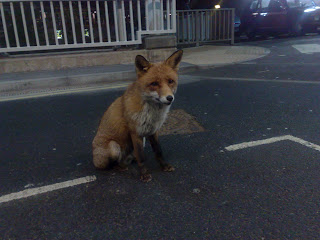Autumn has passed, before I knew it, and given way to winter. Come to think of it, although it's only January, winter seems to be on the way out as well! So no more shots of trees in their fiery autumnal raiment, it's time to make the best of what winter provides. What does it provide, at least for the photographer? It can be difficult, depending on where you live. Over here in the UK, most of the time, one is confronted with bare trees, and little more of anything interesting. Sure, you can do a lot with bare branches, but what else is there?
Unless, of course, it snows! That's when every amateur (and pro) worth their salt go crazy, donning their cold weather gear to tramp out into strangely altered surroundings, shooting pictures of their homes, partners, children and the family dog smothered in the white stuff. And once those are done, one turns one's attention further afield, to the fields, roads and woods, perhaps on the way to work, or, more likely, because one is "working from home" as all transport links are down...
So what does one need to take half-decent pictures in the snow? Warm clothing, for one. Camera shake is a problem when you're shivering. And hands going numb can be a real problem - I've missed a couple of shots of moving things because I couldn't get my shutter finger to work! (And the agony when you thrust your hands back into your pockets and they start to thaw...!). Camera settings are important, too (if you're using a camera that has manual settings as an option, that is). Of these, the white balance is probably the most important. All that white snow, coupled with a typically grey sky, can do funny things to your image. Experiment with different white balance settings - some of them, depending on the ambient light, can help you capture a more realistic image than a "recommended" one. Of course, you might like the effects provided by a "non-realistic" setting - such as a cool blue tint, which immediately brings out the coldness of the surroundings in an image.
And it goes without saying that you need to be careful with exposures - all that whiteness again. The one advantage of snowy shots is that you don't often have to deal with overexposed skies or under-exposed foreground - the whiteness on the ground pretty much reflects what's in the sky - murky or dazzlingly bright. What if it's actually snowing, though? That's actually easier to deal with than rain - for one, it doesn't soak camera and lens as quickly and thorougly as water, so you can actually take your camera out for a minute or two before having to shelter it. And the relative slowness and size of snowflakes makes them easier to shoot. Depending on how long an exposure you set, you can capture an impression of falling snow with nice, slanting lines of white crisscossing your picture. The picture of the horses at the beginning illustrates just what I mean. That shot of mine, incidentally, was used by Ellenor Lions, a local charity, for their 2011 calendar.
 However, don't completely dismiss your "auto" setting; on a recent trip to Iceland, it was so cold that I couldn't keep my fingers exposed any more, and had to put on my thick felt gloves with which all I could do was press the shutter release. So I set my camera to "auto" and hoped for the best - and nearly all the shots turned out surprisingly well, in many cases more balanced that the settings I would
However, don't completely dismiss your "auto" setting; on a recent trip to Iceland, it was so cold that I couldn't keep my fingers exposed any more, and had to put on my thick felt gloves with which all I could do was press the shutter release. So I set my camera to "auto" and hoped for the best - and nearly all the shots turned out surprisingly well, in many cases more balanced that the settings I would
have chosen - like this shot of Thingvellir National Park.
To sum up, when shooting in snow keep warm, protect your camera and play around with the settings. And don't be afraid to experiment! More on my "experiments" in my next post.


